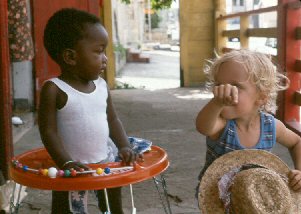 |
||
Experiential language learning: Learn like a child
What do we mean when we say experiential language learning? It means to learn language the way a child doesthrough experiencing his environment and being taught by the native speakers that surround him. Of course, in your language journey, you are not a child so you wont have exactly the same experience, but let me share some examples with you. Three examples of the child language learner come to mind. Each one teaches a language learning lesson. Let me explain. Practice, Practice, PracticeWhile studying Swedish, I watched enviously as a toddler on the bus babbled at a stranger. Although, Swedes tend to be reserved and rarely talk to strangers, the mom encouraged the child to say "Hej" (pronounced "hey;" it is Swedish for "Hi"). When a sound remotely similar came out, she praised and cuddled her child. The stranger was a receptive listener, encouraging the child with a friendly look. I suspect if I had tried this approach, I would have been met with stony silence. Watching this, I longed for a similar friendly opening to talk to strangers. Instead, I had to find other places to practice Swedish. Just as the mother enlisted the day-to-day environment to teach her child, I utilized my daily surroundings to aid me in my experiential language learning. For example, I created dialogs to talk with my Swedish classmates about common interests: hobbies and music. At home, I posted labels on common household objects: counter, cupboard, table, chair, etc. Thus, I used the people and objects in my world to help me learn Swedish. Take RisksAs I've watched my own sons learn English, I've seen them boldly experiment with the new sounds and words, figuring out what works and what doesn't. When they say something funny, we laugh, and they laughs with us. Now, we are working on learning Spanish language. Do the same thing when you are learning your next language. Try out new sounds and keep practicing until you get close enough for a native speaker to understand you easily. Experiment with new concepts and constructions until you get them. When people laugh at you (they will, I promise), laugh with them. It will hurt less, and people will be more willing to help you if you don't get testy. The important thing is to make it an adventure, and enlist your associates to help. Use GesturesIf all else fails, use all possible methods to communicate. The picture above shows my brother, Shawn, when we were in Antigua, West Indies. He was playing with a local child and since they didn't speak the same language, Shawn employed a reservoir of gestures and pantomime so that he could play with this boy. During your language learning, you can employ the similar techniques, gesturing and acting out information that you want to convey. Miming an action is often a great way to get your listners to teach you new vocabulary. SummaryThe key of experiential language learning, then is to be childlike. You cant act childish, but you can learn from the examples of children learn language.
If you want an easy-to-use guide to put the skills of the child learner into practice, then download the Walkabout Language Learning Action Guide. It will show you how do all of these things, plus more. Return from Experiential Language Learning to Introduction to Walkabout Language Learning Return to Your Language Guide Home |

Experiential Language LearningSometimes you will want to express ideas for which you don't have the vocabulary. At other times you will hear words for concepts you don't understand. Preparing for these occasions is different from preparing for a predicable situation. --Dr. Terry Marshall, Whole World Guide to Language Learning, 98 Practice, practice, and most especially, public practice will carry you through your language learning journey.  The Whole World GuideLove the ideas and language learning tips here in our website? Want to learn more about the Walkabout method? Buy your own copy of The Whole World Guide to Language Learning: How to live and learn any foreign language. This book is chock full of ideas on how to use Walkabout language learning. It has sample lesson plans as well as language learning drills and practice tips. Order your copy today. |
|
|
Enjoy This Site?
Then why not use the button below, to add us to your favorite bookmarking service? |
||
|
Home | Contact | About | Privacy Policy
Copyright© 2007-2016 YourLanguageGuide.com |
||
|
| ||
New! Comments
Have your say about what you just read! Leave me a comment in the box below.